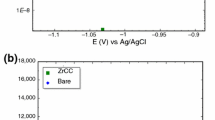Abstract
To protect the base metal from corrosion, different types of coating systems and coating process are an area of continuous development. Galvannealed (GA) coating is one of the most suitable coated sheet to satisfy the requirement in automobile industry. It was observed that the zinc starts to oxidise or corrode during the transport or storage time. To delay this oxidation or corrosion of zinc, a secondary coating is being given after GA sheet production, that also improve certain properties of the GA coating like, welding, high temperature performance etc. Many times, it is seen that the adhesion of secondary coating like electroplating deteriorates due to use of older and oxidized GA sheets. Generally, before electroplating, the GA sheet was cleaned by convention degreasing (Ammonium chloride–NH4Cl, pH 4.0) process. In the present work, it was investigated that zinc oxide layer (i.e. corroded zinc) was formed on top of older GA surface cannot be removed or dissolved by conventional alkaline solution. This has resulted in poor adhesion between GA and secondary electroplated coating. Those secondary coating peeled off during high temperature processes and 90° bend test. In this work, modifications were done during degreasing process which improve the adhesion of secondary electroplated coating. High concentration degreasing solution (pH 12.5) was used and the dipping time of the sample into the degreasing solution was increased from 20–30 s to 40–90 s. This enhances the dissolution of the zinc oxide layer from top of the GA coating and improve the adhesion between GA and electroplating coating. Ni anode, conventional Watt’s bath and current density 400 A/m2 for 8 min were maintained for electroplating. Ni coating thickness was maintained 6–8 µ. Coating thickness, cross-section, compositional analysis was done by using scanning electron microscopy (SEM), adhesion was checked by high temp 90° bend test.
Access this chapter
Tax calculation will be finalised at checkout
Purchases are for personal use only
Similar content being viewed by others
References
Marder AR (2000) The metallurgy of zinc-coated steel. Prog Mater Sci 45:191–291. https://doi.org/10.1016/S0079-6425(98)00006-1
Howe P, Kelley SC (1988) A comparison of the resistance spot weldability of bare, hot-dipped, galvannealed and electrogalvanized DQSK sheet steels, SAE technical paper no. 880280, SAE, Warrendale, PA
Landriault JP, Harrison FW (1987) Comparison of thermally alloyed Zn-Fe coatings produced by mechanical wiping to those produced by post-coating annealing. CIM Bull 80(904):71–78
White CL, Lu F, Kimchi M, Dong P (1998) Resistance welding electrode wear on galvannealed steels, zinc-based steel coating systems: production and performance. In: Goodwin FE, (ed) TMS, Warrendale, PA, p 219
Campos A, Guerreo-Mata MP, Colas R, Gazra R (2002) Weldability of galvannealed interstitial free steel. ISIJ Int 42(8):876–881. https://doi.org/10.2355/isijinternational.42.876
Hada T, Fujiwara T, Kanamaru T, Nakayama M, Horita T (1985) ASM Met./Mater. Technol. Ser. Pap., No. 8512-005
Satoh N (1987) Effects of heavy metal additions and crystal modification on the zinc phosphating of electrogalvanized steel sheet. Surf Coat Technol 30(2):171–181. https://doi.org/10.1016/0257-8972(87)90141-1
Narayanan TSNS (2005) Surface pretreatment by phosphate conversion coatings–a review. Rev Adv Mater Sci 9:130–177
Pradhan D, Dutta M, Venugopalan T (2016) Ni-flash-coated galvannealed steel sheet with improved properties. JMEPEG 25:4996–5006. https://doi.org/10.1007/s11665-016-2290-2
McCafferty E (2009) Thermodynamics of corrosion: pourbaix diagrams, introduction to corrosion science pp 95–117
Author information
Authors and Affiliations
Editor information
Editors and Affiliations
Rights and permissions
Copyright information
© 2022 The Author(s), under exclusive license to Springer Nature Singapore Pte Ltd.
About this paper
Cite this paper
Kumar Halder, A., Chakraborty, A. (2022). Investigation of the Degreasing Process to Improve Adhesion Between Oxidized Galvannealed Coating and Electroplated Nickel. In: Kumari, R., Majumdar, J.D., Behera, A. (eds) Recent Advances in Manufacturing Processes. Lecture Notes in Mechanical Engineering. Springer, Singapore. https://doi.org/10.1007/978-981-16-3686-8_4
Download citation
DOI: https://doi.org/10.1007/978-981-16-3686-8_4
Published:
Publisher Name: Springer, Singapore
Print ISBN: 978-981-16-3685-1
Online ISBN: 978-981-16-3686-8
eBook Packages: EngineeringEngineering (R0)




